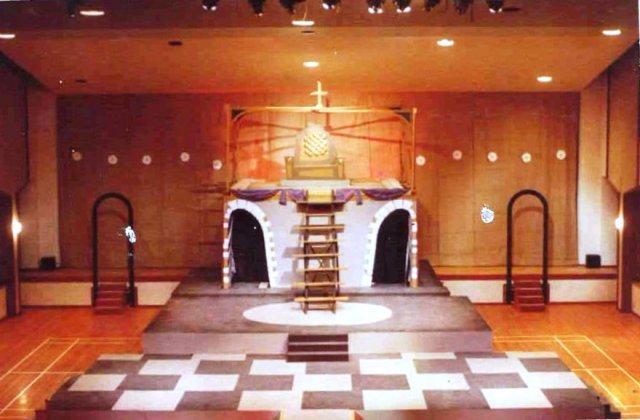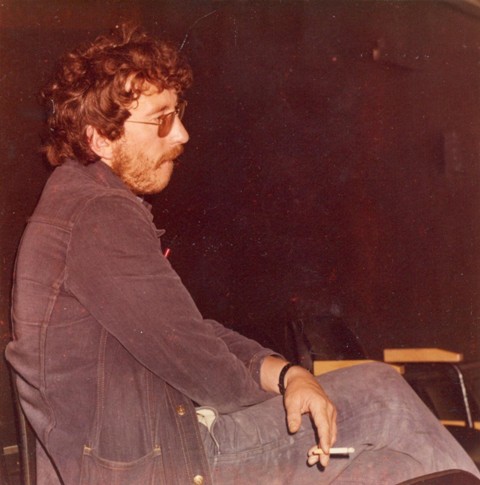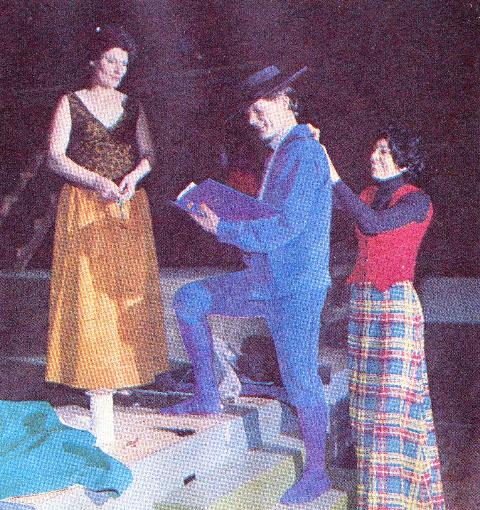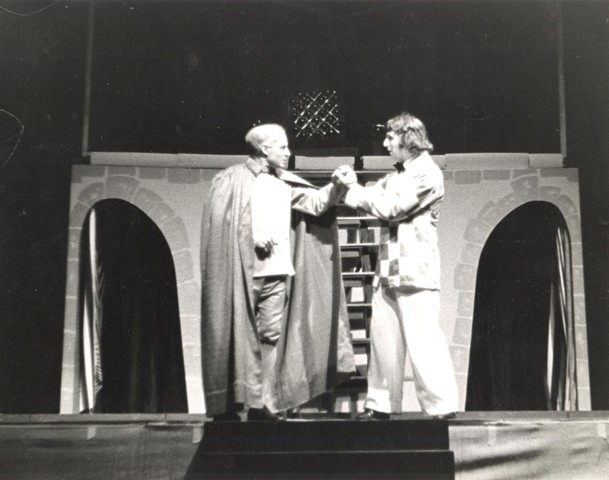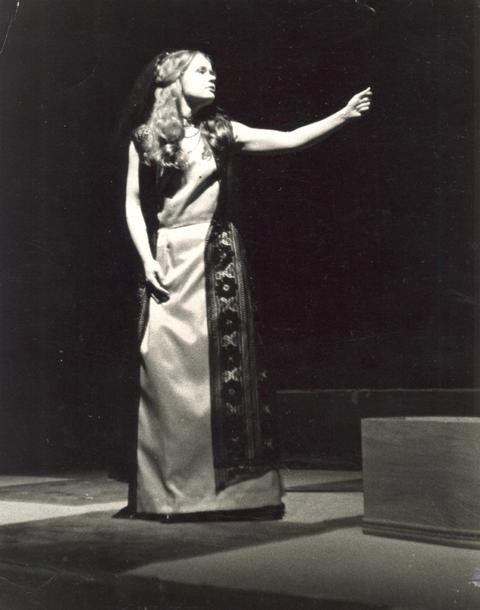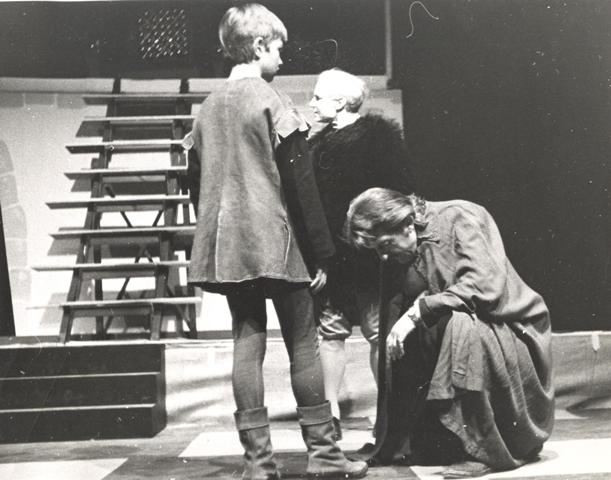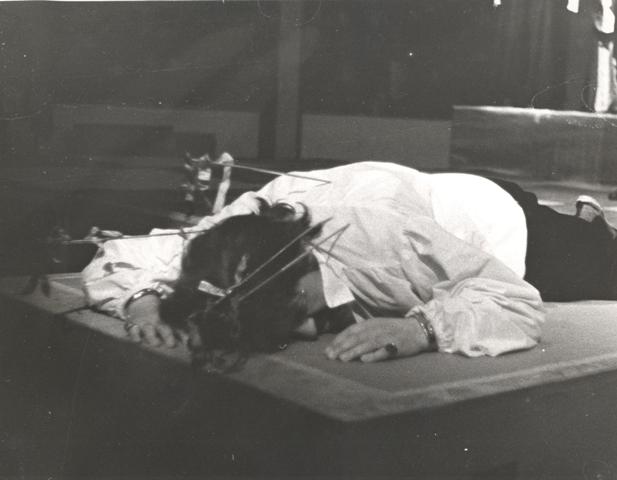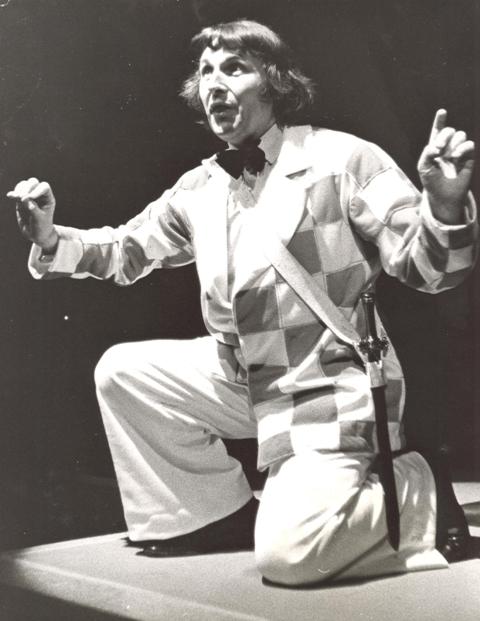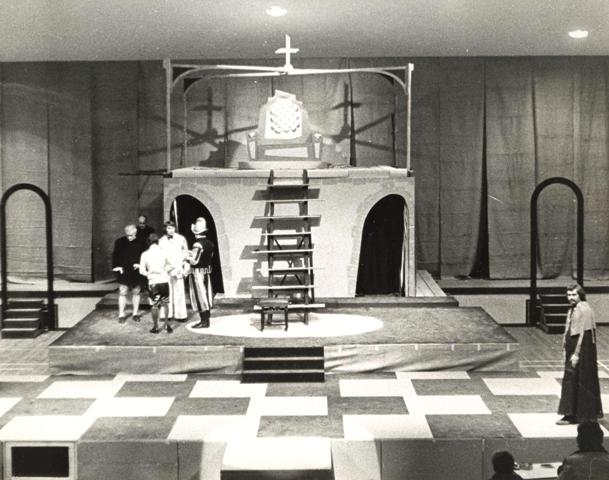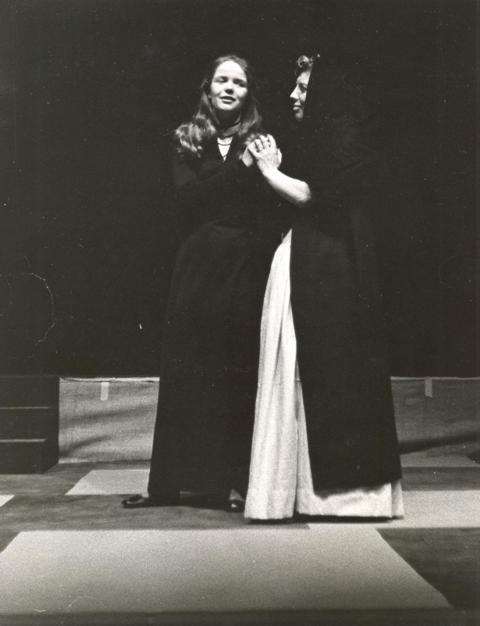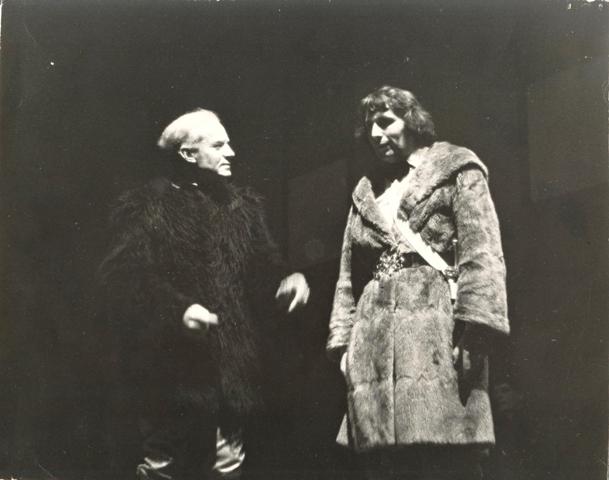The Bench Production
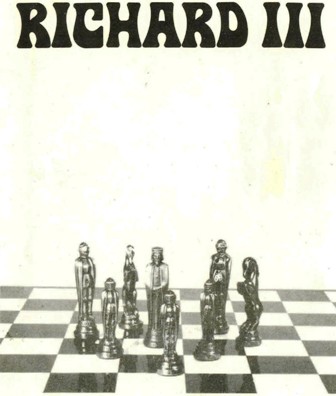
This play was staged under Bench Theatre's original company name of Theatre Union at Oaklands School, Crookhorn, with a lavish stage, colourful costumes and a modern twist.
It was actually the building in West Street, Havant where most of the Company's early plays were staged, which was called the Bench Theatre (after its prior use as a magistrates' court). The company's name was changed gradually by word of mouth and general usage between the years 1973 - 1977 when reviewers, and then members themselves, gradually stopped referring to Theatre Union and started calling the company of players 'Bench Theatre'. The new Company name of Bench Theatre was adopted in to all the promotional literature after they moved from the old theatre (which had been their home for nearly 7 years) in to the Old Town Hall building in East Street.
Cast
| King Edward IV | Brian Montefiore |
| Edward, Prince of Wales | Alan Ross |
| Richard, Duke of York | Melanie Burness |
| George, Duke of Clarence | Derek Cusdin |
| Richard, Duke of Gloucester, later Richard III | John Scadding |
| Cardinal Bourchier | John Hadley |
| Archbishop of York | Derek Cusdin |
| Bishop of Ely | Tim Morris |
| Duke of Buckingham | Tim Mahoney |
| Earl Rivers | David Lings |
| Marquess of Dorset | John Hadley |
| Lord Grey | Martin King |
| Lord Hastings | Ray Osborne |
| Lord Stanley | Peter Holding |
| Lord Lovell | Martin King |
| Sir Richard Ratcliffe | Jim Jevons |
| Sir William Catesby | David Anderson |
| Sit James Tyrrel | Brian Montefiore |
| Sir Robert Brackenbury | David Spackman |
| A Priest | Brian Sweatman |
| Lord Mayor | David Lings |
| Tressel | Tim Morris |
| Berkeley | Laurence Arnold |
| Messenger | Martin Rodnight |
| Elizabeth, Queen to Edward IV | Benita Oakley |
| Margaret, Widow to Henry VI | Tessa Daines |
| Duchess of York | Cindy Prowse |
| Lady Anne | Ingrid Caddy |
| The Shore Sisters | Eve Moore Joan Jevons |
| Servants, Soldiers and Attendants | Sheila Dolman Raymond King Colin Webb Mark Preston Peter Brown Angela Skinner Rachel Reed Michael Jones |
Crew
| Director | Peter Corrigan |
| Designer | David Lings |
| Music Composed and Directed by | Tony Starr |
| Stage Manager | Laurie Noble |
| Wardrobe Mistress | June Jaques |
| Properties | Mike Cuzner |
| Make-up | Catherine Van der Heijden |
| House Manager | Derek Ream |
| Lighting | Peter Orford |
| Choreography | Eddie Ambrose |
Director's Notes
To think that the play portrays historical fact is to be naive. Most of Shakespeare's sources had been strongly influenced by Tudor propaganda and he was, after all, living and writing during the reign of a Tudor monarch. It does, however, portray and analyse the passion of ambition. This passion infects nearly all the characters to some degree and rather than the tragedy of Richard III, a better title to me would seem to be the tragedy of the others. Selfishness, greed, ambition, ineptitude, surrounded by uncertainty abound in the corridors of power where Richard stalks his victims. These sort of conditions prevailed during the rise of Hitler, where the refusal to take their danger seriously resulted resulted in the overthrow of those who had the power to prevent him. If we look closely at those conditions, ineptitude in government inflation, lack of direction, constant squabbling amongst themselves, we might recognise that the embryo counterparts exist here today and perhaps if we looked closely enough we might find our own Richard III.
Our approach in this production has been simply to point up the downfall of the others and our version (a word I prefer to adaptation) is entirely Shakespeare's with just the downfall of Richard removed and a few effects which owe their origin to a Barnum and Bailey circus added for emphasis. It is after all, the longest of his historical plays, and longer than any others except 'Hamlet'.
It would have needed cuts to make it a viable project, and we have simply removed the naive arrival of a heroic angelic rescuer; if a Richard-like character reaches the centre of power it is our fault and arguably too late.
Peter Corrigan
Designer's Notes
Richard III began with the idea that we would write our own version and take from Shakespeare the ideas that could be used to reproduce the nightmarish qualities and from this, one's mind went immediately to artists such as Breugel, Bosch and Salvador Dali. From these artists and the beautiful, but macabre atmosphere reproduced in the German Expressionist film 'Dr Caligari's Cabinet' ideas for the original set were produced. One idea was to reproduce something reminiscent of Bosch's work in his famous tryptich of Paradise and Hell. The influence of these ideas have not altogether been lost as there is still something nightmarish about the character of Richard as portrayed in Shakespeare's original and in this production.
At one stage it was thought that we would keep more completely to Shakespeare's script as this had so much to offer. Although the script as we have used it has been cut down, the influence in this production has been derived from the characterisation of Shakespeare's Richard. Power became the theme and the drawing of a comparison between the inherent qualities of the characters portrayed with those of our contemporary setting. This tended to open up the possibilities for design. Originally the designs were based on the period 1480 to 1485. As these new ideas began to germinate, the deigns had to be abandoned. However, as you may be able to gather, all these influences have not been entirely lost.
One idea was to reproduce the power theme as a gigantic chess game. This influence has been kept in the designs for the tickets and the posters. The period lent itself to this interpretation due to the Wars of the Roses which had been the means of bringing Edward to the throne. This is why the red and white chess theme has been kept for the graphic work.
The costumes became finally a progression of design as we designed the play around the concept of three parts which have been loosely entitled 'Summer, Autumn and Winter'. In Part I the costumes are gay and lavish; in Part II the austerity of Autumn has influenced the colours and in Part III Winter arrives with the dominating theme of stark black and white.
The set was originally designed for the stage, to produce a multipurpose set to be able to use interiors and exteriors with a number of levels. This was designed with distorted angles and shapes to try and keep the nightmarish quality. It was discovered that the stage could not easily be used as it was too far from the seating area to be really effective. These designs were eventually scrapped and simplified and brought forwards off of the stage.
After six months work these influences culminated in the final ideas for the design of the set, and the design for the set as you see it was drawn up. The centre piece represents the two symbols of power, the arches being the symbol of the crown enclosing the other symbol, the throne which has a golden orb on the back, part of the sign of King Edward. This meant that all of the work then had to begin to put the designs into effect at a slightly later date than originally anticipated.
David Lings
Reviews
The NewsAnon
New-look Richard III would baffle the Bard
With a fanfare of trumpets Havant's Bench Theatre took to the open stage last night and caused a sensation with its version of Shakespeare's 'Richard III'. For this production the players abandoned their usual tiny, but intimate, theatre in West Street, Havant, and took full advantage of the vast space at Oaklands School theatre in Stakes Hill Road, Waterlooville. Under the direction of Peter Corrigan, the cast broke away from the traditional format and Shakespeare would have had difficulty in recognising some of this version, which included 'Land of Hope and Glory', a tango, and a rather brutish bull-ring type murder of Lord Hastings.
The title role was taken by John Scadding who made a fine feast of his part. Instead of the stereotype Richard III - miserable, hunch-backed and deformed - John presented the audience with a clownish schemer who was moved to tears or hysterical laughter by his own fiendish plots. Master of his art, this actor deserved the leading part and if he intends to give the same energetic and exhausting performance all week he deserves a medal. The ingenious use of costumes completely overturns the historical sequence of the play. The actors all start in 15th century dress but by the second part Richard is dressed in golfing plus-fours and the Duke of Buckingham is in a dinner jacket and Court Guards end up looking like members of the Gestapo. But the best surprise of all is at the end, and to reveal that secret would ruin an amazing finale which had the audience gasping in disbelief.
The music specially composed and directed by Tony Starr, was outstanding and gave members of the Bench Theatre a chance to show they can sing as well as act. Some fine performances were given by Ingrid Caddy as Lady Anne, Benita Oakley as Elizabeth and Tim Mahoney as the Duke of Buckingham. Alan Ross(13) and Melanie Burness(9) took the roles of the young princes murdered in the tower. David Lings was the designer and Peter Orford was in charge of the lighting. Richard III, presented in conjunction with Oaklands School, continues until Saturday. A civic party, headed by the Mayor of Havant (Mr John Derben) attended last night's performance.
The News, 29th April 1974
